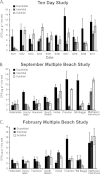Relationship between enterococcal levels and sediment biofilms at recreational beaches in South Florida
- PMID: 22706061
- PMCID: PMC3416616
- DOI: 10.1128/AEM.00603-12
Relationship between enterococcal levels and sediment biofilms at recreational beaches in South Florida
Abstract
Enterococci, recommended at the U.S. federal level for monitoring water quality at marine recreational beaches, have been found to reside and grow within beach sands. However, the environmental and ecological factors affecting enterococcal persistence remain poorly understood, making it difficult to determine levels of fecal pollution and assess human health risks. Here we document the presence of enterococci associated with beach sediment biofilms at eight south Florida recreational beaches. Enterococcal levels were highest in supratidal sands, where they displayed a nonlinear, unimodal relationship with extracellular polymeric secretions (EPS), the primary component of biofilms. Enterococcal levels peaked at intermediate levels of EPS, suggesting that biofilms may promote the survival of enterococci but also inhibit enterococci as the biofilm develops within beach sands. Analysis of bacterial community profiles determined by terminal restriction fragment length polymorphisms showed the bacterial communities of supratidal sediments to be significantly different from intertidal and subtidal communities; however, no differences were observed in bacterial community compositions associated with different EPS concentrations. Our results suggest that supratidal sands are a microbiologically unique environment favorable for the incorporation and persistence of enterococci within beach sediment biofilms.
Figures







References
-
- Alekseeva TN, Sval'nov VN. 2005. The refined wet sieving method for the analysis of fine-graded sediments. Lithol. Mineral Resources 40: 564–576
-
- Alm E, Burke J, Hagan E. 2006. Persistence and potential growth of the fecal indicator bacteria, Escherichia coli, in shoreline sand at Lake Huron. J. Great Lakes Res. 32: 401–405
-
- Andrews RE, Jr, Johnson WS, Guard AR, Marvin JD. 2004. Survival of enterococci and Tn916-like conjugative transposons in soil. Can. J. Microbiol. 50: 957–966 - PubMed
Publication types
MeSH terms
Substances
Associated data
- Actions
- Actions
- Actions
- Actions
- Actions
- Actions
- Actions
- Actions
- Actions
- Actions
- Actions
- Actions
- Actions
- Actions
- Actions
- Actions
- Actions
- Actions
- Actions
- Actions
- Actions
- Actions
- Actions
- Actions
- Actions
- Actions
- Actions
- Actions
- Actions
- Actions
- Actions
- Actions
- Actions
- Actions
- Actions
- Actions
- Actions
- Actions
- Actions
- Actions
- Actions
- Actions
- Actions
- Actions
- Actions
- Actions
- Actions
- Actions
- Actions
- Actions
- Actions
- Actions
- Actions
- Actions
- Actions
- Actions
- Actions
- Actions
- Actions
- Actions
- Actions
- Actions
- Actions
- Actions
- Actions
- Actions
- Actions
- Actions
- Actions
- Actions
- Actions
- Actions
- Actions
- Actions
- Actions
- Actions
- Actions
- Actions
- Actions
- Actions
- Actions
- Actions
- Actions
- Actions
- Actions
- Actions
- Actions
- Actions
- Actions
- Actions
- Actions
- Actions
- Actions
- Actions
- Actions
- Actions
- Actions
- Actions
- Actions
- Actions
- Actions
- Actions
- Actions
- Actions
- Actions
- Actions
- Actions
- Actions
- Actions
- Actions
- Actions
- Actions
- Actions
- Actions
- Actions
- Actions
- Actions
- Actions
- Actions
- Actions
- Actions
- Actions
- Actions
- Actions
- Actions
- Actions
- Actions
- Actions
- Actions
- Actions
- Actions
- Actions
- Actions
- Actions
- Actions
- Actions
- Actions
- Actions
- Actions
- Actions
- Actions
- Actions
- Actions
- Actions
- Actions
- Actions
- Actions
Grants and funding
LinkOut - more resources
Full Text Sources
Molecular Biology Databases

